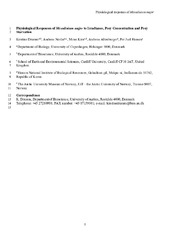Physiological Responses of Mesodiniummajor to Irradiance, Prey Concentration and Prey Starvation
Permanent lenke
https://hdl.handle.net/10037/22133Dato
2021-04-18Type
Journal articleTidsskriftartikkel
Peer reviewed
Sammendrag
Ciliates within the Mesodinium rubrum/Mesodinium major species complex harbor chloroplasts and other cell organelles from specific cryptophyte species. Mesodinium major was recently described, and new studies indicate that blooms of M. major are just as common as blooms of M. rubrum. Despite this, the physiology of M. major has never been studied and compared to M. rubrum. In this study, growth, food uptake, chlorophyll a and photosynthesis were measured at six different irradiances, when fed the cryptophyte, Teleaulax amphioxeia. The results show that the light compensation point for growth of M. major was significantly higher than for M. rubrum. Inorganic carbon uptake via photosynthesis contributed by far most of total carbon uptake at most irradiances, similar to M. rubrum. Mesodinium major cells contain ~four times as many chloroplast as M. rubrum leading to up to ~four times higher rates of photosynthesis. The responses of M. major to prey starvation and refeeding were also studied. Mesodinium major was well adapted to prey starvation, and 51 d without prey did not lead to mortality. Mesodinium major quickly recovered from prey starvation when refed, due to high ingestion rates of > 150 prey/predator/d.
Beskrivelse
This is the peer reviewed version of the following article: Drumm, K., Norlin, A., Kim, M., Altenburger, A. & Hansen, P. E. (2021). Physiological Responses of Mesodiniummajor to Irradiance, Prey Concentration and Prey Starvation. The Journal of Eukaryotic Microbiology, 68(4)., which has been published in final form at https://doi.org/10.1111/jeu.12854. This article may be used for non-commercial purposes in accordance with Wiley Terms and Conditions for Use of Self-Archived Versions. This article may not be enhanced, enriched or otherwise transformed into a derivative work, without express permission from Wiley or by statutory rights under applicable legislation. Copyright notices must not be removed, obscured or modified. The article must be linked to Wiley’s version of record on Wiley Online Library and any embedding, framing or otherwise making available the article or pages thereof by third parties from platforms, services and websites other than Wiley Online Library must be prohibited.
Forlag
WileySitering
Drumm K, Norlin, Kim, Altenburger A, Hansen PJ. Physiological Responses of Mesodinium major to Irradiance, Prey Concentration and Prey Starvation. Journal of Eukaryotic Microbiology. 2021Metadata
Vis full innførselSamlinger
© 2021 International Society of Protistologists


 English
English norsk
norsk